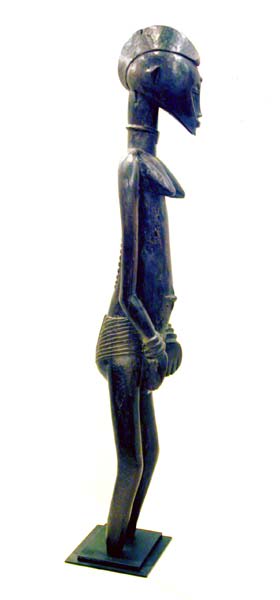Senufo Wooden Pombibele Rhythm Pounder, 19th Century CE
Wood
8 x 47
X.0685 (LSO)
Further images
This is a rhythm pounder or pombibele figure from the Senufo people of the Ivory Coast. The current figure is female, naked except for a small loincloth. The head is...
This is a rhythm pounder or pombibele figure from the Senufo people of the Ivory Coast. The current figure is female, naked except for a small loincloth. The head is pointed to a sharp chin, and crowned with a crested headpiece running sagittally. The face is in a pose of serene impassivity, with half closed eyes, a long nose and a nugatory mouth. It has a small eminence in the mid forehead. The face is dished in contrast to the rounded shape of the head. The ears are small and triangular, and jut out at right angles to the head. The neck is very elongated, and is decorated with a single carved necklace. The breasts are high and pointed, and are positioned almost at the shoulders. The arms flow from neck height and are slim and elongated. The forearms are relatively short for the upper arms, and are decorated with three bracelets on each side. The hands are demurely placed upon either side of the loincloth. The legs are slim, the right casually bent with the body’s weight being supported by the left leg. The feet have been removed and the figure has been mounted on a metal stand. The navel is scarified.
The Senufo group’s extremely high level of skill in woodcarving is nowhere better seen than in the realm of their magical-religious art. At the heart of Senufo society is a patriarchal groups of elders known as the Poro society; their ceremonial events are often associated with dancing, music and the use of Pombibele sculptures. Pombibele literally translates as “those who give birth”, representing (when in pairs) primordial humanity and the ancestry of all humankind. Most examples, however, are of single, female figures. The appearance of these figures is relatively homogenous, being tall, slim and somewhat angular. However, the personal characteristics of each sculpture were often based upon a dream or vision by a Poro elder. The figures were used either as pounding devices to keep the rhythm for dancing, or were stood for purposes of contemplation in the middle of the Poro society’s sacred enclosures. They were also used to tamp down the soil on deceased Poro members’ graves to ensure that the spirit went towards the afterlife and did not persist in the realm of the living.
The wood is highly patinated and polished, and the figure is in excellent condition. There is slight use wear on the arms, seeming to suggest that the figure may indeed have been used as a pounder, rather than merely as a contemplative object. This is an exceptionally beautiful and important piece of African artistic heritage and social history.
The Senufo group’s extremely high level of skill in woodcarving is nowhere better seen than in the realm of their magical-religious art. At the heart of Senufo society is a patriarchal groups of elders known as the Poro society; their ceremonial events are often associated with dancing, music and the use of Pombibele sculptures. Pombibele literally translates as “those who give birth”, representing (when in pairs) primordial humanity and the ancestry of all humankind. Most examples, however, are of single, female figures. The appearance of these figures is relatively homogenous, being tall, slim and somewhat angular. However, the personal characteristics of each sculpture were often based upon a dream or vision by a Poro elder. The figures were used either as pounding devices to keep the rhythm for dancing, or were stood for purposes of contemplation in the middle of the Poro society’s sacred enclosures. They were also used to tamp down the soil on deceased Poro members’ graves to ensure that the spirit went towards the afterlife and did not persist in the realm of the living.
The wood is highly patinated and polished, and the figure is in excellent condition. There is slight use wear on the arms, seeming to suggest that the figure may indeed have been used as a pounder, rather than merely as a contemplative object. This is an exceptionally beautiful and important piece of African artistic heritage and social history.







